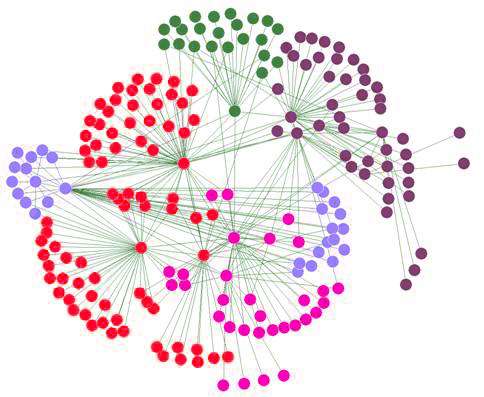Social network diagram. Credit: Daniel Tenerife/Wikipedia
(Phys.org)—A trio of researchers affiliated with the University of Oxford in England and Aalto University School of Science in Finland has conducted a study of human behavior and has found evidence backing up a prior theory that suggests humans have different layers that make up their social circle with different numbers of people in them. In their paper uploaded to the preprint server, arXiv, they describe their study which involved analyzing cell phone records to count calls, what they found and that they believe it means for us a group.
One of the researchers, Robin Dunbar, was part of a team that back in the 1990's studied the correlation between brain size in primates and the number of individuals in their social groups. They found that the bigger the brain, the more members of their groups. More recently, he and colleagues have conducted some experiments that suggest that humans have layers or groups of contacts, with the closet layers having fewer people, and the farthest, more. He and his team have suggested that there are actually four layers, which cumulatively contain 5, 15, 50 and 150 people respectively, with the final layer representing the 150 total that was theorized back in the nineties. To give more credence to this theory, the researchers conducted a study of phone records of people living in an undisclosed European country during 2007 (prior to Facebook and smartphones). They narrowed the initial 6 billion calls down to those that involved people who on average called approximately 130 other people, making approximately 10 calls per day. The idea was that people call those that are closer to them more often, thus counting the calls between individuals would reveal how many people were in each of their layers. The team also screened out business and casual calls and also those calls from people that clearly did not use their phone as a means of social contact.
In the end, the team did find clustering that appeared to correlate with their layer theory, with people having on average, 4.1, 11, 29.8, and 128.9 people in their layers, which was small but close to the numbers they had derived for their theory—close enough to fit in with natural variation, they claim. They did find some exceptions to the rule, such as for those people who were clearly extroverts or introverts, which the teams suggests, may mean such people may have an extra layer.
More information: Calling Dunbar's Numbers, arXiv:1604.02400 [physics.soc-ph] arxiv.org/abs/1604.02400
Abstract
The social brain hypothesis predicts that humans have an average of about 150 relationships at any given time. Within this 150, there are layers of friends of an ego, where the number of friends in a layer increases as the emotional closeness decreases. Here we analyse a mobile phone dataset, firstly, to ascertain whether layers of friends can be identified based on call frequency. We then apply different clustering algorithms to break the call frequency of egos into clusters and compare the number of alters in each cluster with the layer size predicted by the social brain hypothesis. In this dataset we find strong evidence for the existence of a layered structure. The clustering yields results that match well with previous studies for the innermost and outermost layers, but for layers in between we observe large variability.
Journal information: arXiv
© 2016 Phys.org
























